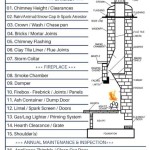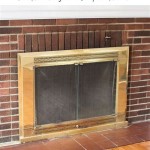Elegant Tile Around Fireplace Ideas: Enhancing Your Hearth
The fireplace serves as a focal point in many homes, providing warmth, ambiance, and aesthetic appeal. The surrounding area, often referred to as the fireplace surround or hearth, presents an opportunity to further enhance the design and functionality of this key space. Tile offers a durable, versatile, and visually appealing solution for facing a fireplace. The selection of tile requires careful consideration of factors such as style, material, color, and heat resistance to create a harmonious and safe design.
The role of tile extends beyond pure aesthetics. It also provides a protective layer for the surrounding wall, shielding it from the intense heat generated by the fireplace. Furthermore, tile is relatively easy to clean and maintain, making it a practical choice for an area prone to soot and ash. This article explores various tile options and design considerations to inspire the creation of a stunning and functional fireplace surround.
Key Considerations Before Tiling Your Fireplace
Before embarking on a tiling project, it's crucial to address several fundamental aspects. These considerations will affect the ultimate aesthetic and performance of the tiled fireplace surround. Neglecting these points can lead to costly mistakes and dissatisfaction with the final result.
Firstly, assess the existing structure of the fireplace. Determine the material of the surrounding wall and the hearth. This assessment will influence the choice of mortar and adhesive required for proper tile installation. Concrete, brick, and drywall each require different approaches. In the case of drywall, ensuring proper fireproofing is crucial before tiling. Cement board, a fire-resistant material, is often recommended as a backer board for tile in fireplace applications.
Secondly, evaluate the heat exposure. Not all tiles are created equal in terms of heat resistance. Natural stone like slate and travertine, as well as porcelain and ceramic tiles, are generally suitable for fireplace surrounds. However, it's essential to verify the specific tile's heat rating with the manufacturer. Avoid using tiles that are prone to cracking or discoloration under high temperatures. Glass tiles, while visually appealing, might not be the best choice for areas directly exposed to the fireplace opening.
Thirdly, establish a clear design vision. Consider the overall style of the room and how the fireplace surround will complement the existing décor. Gather inspiration from magazines, online resources, and showrooms to develop a cohesive aesthetic. Pay attention to details such as tile size, shape, color, and pattern. Samples of the chosen tiles should be obtained to assess their appearance under the natural and artificial lighting conditions of the room. Mock up the proposed tile layout to visualize the final design before commencing installation.
Exploring Different Tile Materials and Styles
The selection of tile materials presents a diverse range of options, each with its unique characteristics and aesthetic appeal. Understanding the properties of different materials is essential for making an informed choice that aligns with both the design vision and functional requirements of the fireplace surround.
Natural Stone: Natural stone tiles, such as slate, marble, granite, and travertine, offer a timeless elegance and sophistication. Their inherent variations in color, texture, and veining create a one-of-a-kind look. Slate provides a rustic and earthy feel, while marble exudes a luxurious and refined aesthetic. Granite is known for its durability and resistance to heat, making it a suitable choice for high-heat areas. Travertine offers a warm and inviting texture, often with naturally occurring pits and voids that add character. Natural stone tiles typically require sealing to protect them from staining and moisture.
Ceramic and Porcelain: Ceramic and porcelain tiles are popular choices due to their versatility, affordability, and wide range of styles. Ceramic tiles are made from clay and fired at a lower temperature than porcelain tiles, making them less dense and more porous. Porcelain tiles are denser, more durable, and less absorbent, making them suitable for high-traffic areas and areas exposed to moisture. Both ceramic and porcelain tiles are available in a variety of colors, patterns, and sizes, allowing for endless design possibilities. They can mimic the look of natural stone, wood, or even metal. Furthermore, both are relatively easy to clean and maintain.
Glass Tile: Glass tiles add a touch of contemporary elegance and shimmer to a fireplace surround. They are available in a wide array of colors, shapes, and sizes, and can be used to create intricate mosaic patterns. Glass tiles reflect light, adding depth and dimension to the space. However, it's crucial to select heat-resistant glass tiles specifically designed for fireplace applications. Not all glass tiles are suitable for high-heat environments.
Mosaic Tile: Mosaic tiles consist of small pieces of tile, typically arranged in a pattern or design. They can be made from various materials, including glass, ceramic, porcelain, and stone. Mosaic tiles offer a high degree of customization and can be used to create intricate and visually striking designs. They are often used as accent pieces or to create a focal point within the fireplace surround.
Beyond the material, the style of the tile significantly impacts the overall aesthetic. Consider the following styles:
* Subway Tile: A classic and versatile option that complements a wide range of décor styles. * Geometric Tile: Adds a modern and graphic element to the fireplace surround. * Patterned Tile: Introduces visual interest and personality to the space. * Textured Tile: Creates depth and dimension, adding tactile appeal. * Large-Format Tile: Minimizes grout lines, creating a seamless and modern look.The Installation Process: Ensuring a Professional Finish
Proper tile installation is crucial for ensuring the longevity and aesthetic appeal of the fireplace surround. A meticulous approach and attention to detail are essential for achieving a professional finish. While DIY installations are possible, engaging a qualified tile installer is often recommended, particularly for complex designs or when working with expensive materials. The installer needs to be well versed on local building codes regarding fireplace surrounds.
Preparation: Begin by thoroughly cleaning the surface of the fireplace surround. Remove any existing paint, wallpaper, or debris. Ensure the surface is level and free from imperfections. Apply a layer of cement board as a backer board, securing it to the wall using screws. Tape and mud the seams between the cement boards to create a smooth and continuous surface. Apply a waterproofing membrane to protect the wall from moisture.
Layout and Cutting: Before applying the adhesive, dry-lay the tiles to determine the optimal layout. This step allows for adjustments to minimize cuts and ensure a balanced appearance. Use a tile cutter or wet saw to make accurate cuts for edges and corners. Always wear safety glasses when cutting tiles.
Adhesive Application: Select a suitable tile adhesive specifically designed for fireplace applications and the chosen tile material. Apply the adhesive to the back of the tile using a notched trowel, following the manufacturer's instructions. Ensure even coverage and consistent thickness. Press the tile firmly onto the prepared surface, maintaining consistent spacing between tiles.
Grouting: Allow the adhesive to cure completely before grouting. Remove any excess adhesive from the tile surfaces. Mix the grout according to the manufacturer's instructions. Apply the grout to the tile joints using a grout float, working in a diagonal direction. Remove excess grout with a damp sponge. Allow the grout to cure according to the manufacturer's instructions.
Sealing: After the grout has cured, seal the grout lines with a grout sealer to protect them from staining and moisture. If natural stone tiles are used, they should also be sealed with a stone sealer to prevent staining and enhance their longevity. This sealing process often needs to be repeated at fixed intervals.
Finishing Touches: Install trim pieces, such as bullnose tiles or decorative molding, to create a finished edge around the fireplace surround. Clean the tile surfaces thoroughly with a tile cleaner to remove any grout haze or residue. Inspect the installation for any imperfections and make necessary repairs. The mortar and the grout must be heat-resistant.
By carefully considering the material, style, and installation process, a tile fireplace surround can add beauty, functionality, and value to any home.

Fireplace Tile Ideas Designs To Inspire You

53 Best Fireplace Tile Ideas And Designs With S For 2024 Mantel Decor Modern Marble Surround

14 Fresh Designs For Tiled Fireplaces Bob Vila

Fireplace Tile Ideas Designs To Inspire You
These Tiled Fireplaces Are Swoon Worthy Tileist By Tilebar

Warm Up With Fireplace Tile Ideas Home Remodel Surround

Hot Fireplace Tile Trends Bedrosians Stone

Fireplace Tile Design Ideas For 2024 The

Tiled Fireplace Ideas To Cozy Up Your Space Arizona Tile

Fireplace Feature Wall Ideas Queen City Stone Tile
Related Posts








